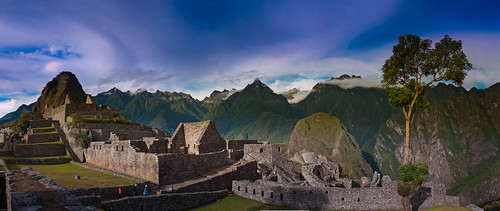We returned last Sunday, and since then I’ve been going through my pictures and digging out of e-mail from work.

The Archeological Site at Machupicchu (click to see larger versions)
When talking about Peru it’s hard to keep the Lost City of the Incas at Machupicchu from taking over the conversation. Certainly, going in, we thought of it as the high point of our trip. Coming out, there were a number of pleasant surprises that provided a well rounded trip.
- Lima:
Our first and last stop in Peru. I had low expectations for this stop, and by only one means did it exceed. The food was good and inexpensive. Lima is a big city, with lots of traffic. While founded in the 1530’s, most of the original buildings have been lost to earthquakes. - Paracas, Ica and Islas Ballestas:
The bus ride there was a pleasant surprise, even if the advertised WiFi access didn’t materialize. The National Reserve at Paracas was breathtaking in its desert simplicity. The bird sanctuary on Islas Ballestas was remarkable, but difficult to shoot with a rocking boat and manual lenses. We took an unplanned sojourn to Ica for dune buggy and sand boarding over the dunes. Incredible. - Nasca:
The lines were the main attraction here, but not all of us were able to handle the roller-coaster-like airplane ride; many of the lines were hard to see. A must see, but a little disappointing. A walk through the food market was fun; the Aqueducts were impressive but the Chacilla cemetery was a miss. - Arequipa:
In some sense, Arequipa is a transfer spot from coast to the highlands. At 2400 meters or so, if offers a place to become acclimatized to the higher elevations of Cusco and the Colca Canyon. While the Monasterio de Santa Catalina was modestly interesting, the Cuy and Alpaca produce were the highlights. (more) - Colca Canyon:
To get to Colca Canyon one must travel along a road that reaches 4900 meter. That’s a real challenge. At that altitude, the best thing to do is sit, drink water, and eat coca leaves. The highlight of this portion of the trip was to see the Andean Condors. These massive birds fly in large numbers and very close in. A definite hit. The canyon itself is impressive, with its depth (deeper than the Grand Canyon) and the terraces and the city of Chivay. - Cusco:
Cusco is the ancient Quechuan (Incan) Capital. Very little of the original city remains, it was levelled by the invading Spanish who built on top of the former’s foundations. What does remain, however, is impressive. At 3600 meters, Cusco can be a challenge to move around in. It takes a day or so to get acclimatized. - Sacred Valley:
This is the route that leads from Cusco to Machupicchu. The valley itself is beautiful. It is green, unlike most other parts of Peru we had seen to date. The Sacred Valley is the gateway to the Amazon. The archeological site at Ollantaytambo is modest but interesting. Yucay, where we spent the night, is rural, quiet and relaxing. - Machupicchu:
Walking the Inca Trail is the popular route to Machupicchu. Alternatives include the train, bus and car. We took the train. Machupicchu is remarkable if not only because it is a site untouched by invaders. It is all one might expect. At the site there are several areas to visit include climbing Waynapicchu, the Inca Trail and the Inca Bridge. - Bogota:
After Peru we stopped over for three days in Bogota, where we toured the city and surrounding area and played a game of golf. Not much golf in Peru; seems to be modestly more in Columbia.
Some other points beyond the itinerary:
- Food:
Peruvian food is good. - Notable firsts:
There were several firsts for me, including first time south of the equator. - General observations:
The people were very friendly; hotel staff were always helpful. Most of the other tourists we met were from Germany, France, Australia/New Zealand and a couple from Italy.

Leave a Reply